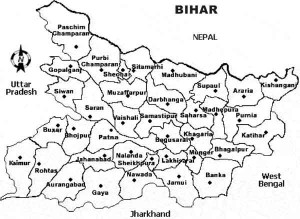It is in Bihar, i.e. in Jahanabad, barely 50 kms away from Patna, the state capital, that the Maoists laid siege to a district town during their attack on the Central Jail on November 2005 to facilitate the escape of over 375 prisoners. It was not a guerilla type of operation. The Maoists attacked the police lines, offices of district administration and the jail simultaneously. The attackers had taken over the town for nearly three hours. The attacking force constituted Maoist cadres from Jharkhand, Chhattisgarh and even Andhra Pradesh.
 It is in Bihar that recently in September 2010, when four policemen were abducted by the Maoists in Lakhisarai district and the only tribal amongst them, Inspector Lucas Tete, was killed in cold blood. Earlier in February 2010, a group of around 200 Maoists had earlier attacked Korasi village in Jamui district and killed 11 people, including three women and a child. Most of the deceased were of the scheduled tribe Koda community, which dominates the region.If the issue was only of tribal disaffection, the casualty (fatalities) would not have been so high in Bihar, especially in the backdrop of the widely hailed good governance in the state for the last six years. If the tribal argument had substance would have been glaring contrast in casualty figures between Bihar and Jharkhand. Moreover it would have not gone beyond the Bihar-Jharkhand border. The casualties in Bihar in the year 2010 were Monghyr-18, Jammui -17, Gaya-16, Aurangabad-13, Sheohar-11, Lakhisarai-8, Rohtas-4, Banka-3, East Chamaran-3, Kamiur-2 and Patna-2. A comparative table is given below:
It is in Bihar that recently in September 2010, when four policemen were abducted by the Maoists in Lakhisarai district and the only tribal amongst them, Inspector Lucas Tete, was killed in cold blood. Earlier in February 2010, a group of around 200 Maoists had earlier attacked Korasi village in Jamui district and killed 11 people, including three women and a child. Most of the deceased were of the scheduled tribe Koda community, which dominates the region.If the issue was only of tribal disaffection, the casualty (fatalities) would not have been so high in Bihar, especially in the backdrop of the widely hailed good governance in the state for the last six years. If the tribal argument had substance would have been glaring contrast in casualty figures between Bihar and Jharkhand. Moreover it would have not gone beyond the Bihar-Jharkhand border. The casualties in Bihar in the year 2010 were Monghyr-18, Jammui -17, Gaya-16, Aurangabad-13, Sheohar-11, Lakhisarai-8, Rohtas-4, Banka-3, East Chamaran-3, Kamiur-2 and Patna-2. A comparative table is given below:
Therefore, the Maoists problem is not about tribal and their rights. However, by conscious design, the benefactors of the Maoists and their urban faces have managed to wean the Indian peoples’ focus of Maoism as it exists in Bihar and West Bengal and Jharkhand, and reduce it to a tribal problem and link it with forest and mining issues. It is not without reason.
 The forests provide the ‘Red Base’ and the illegal exploitation of India’s mineral wealth brings the riches and international leverage, which is growing phenomenally.
The forests provide the ‘Red Base’ and the illegal exploitation of India’s mineral wealth brings the riches and international leverage, which is growing phenomenally.
Development is not the Issue
In Jharkhand and Bihar even in the most Maoist affected areas, the Maoists are in a minority. It is for this reason that they have taken the path of violence and intimidation. In villages, where the Maoists have made strong inroads, there are only few hardcore supporters of the Maoists. The voter turnout during various elections despite the Maoist threat in certain areas is testimony.
after very searching probes and insistence, people from across Jharkhand revealed that there is no “˜hunger or “˜starvation in the state. Not one person said that they were denied rations through BPL cards.
Recently, Panchayat elections were held in Jharkhand after 32 years, and the response was overwhelming despite ‘boycott calls’ by the Maoists in selected areas where they perceived themselves to be politically weak. Many Maoists have also managed to get elected. It remains to be seen whether it will help in democratization of the Maoists and bring them into the mainstream or whether they will further entrench themselves to act as bases for capture of state power in conformity with the objective of the Central Committee of the Maoists.
In Bihar too, the Panchayat elections are being conducted. Some Maoists are participating under the banner of CPI (ML), though they deny it. The CPI (ML) candidates are the only ones who are fighting under party banner. The response to them is lukewarm. The Maoists also issued diktats for poll boycott in certain areas. This is typical of the Maoists who are known to use both underground and over-ground means in their journey for capture of power.
If the absence or lack of development was any issue, there would have been near unanimous support for the Maoists. Moreover, they would not have destroyed schools, hospitals and prevented construction activities.
Bihar today has one of the best road communications in the country, both in terms of network and quality. The few very ugly patches are in the areas, where the Maoist threat is high and the contractors are being harassed for levy in amounts, which they can ill afford to pay.
The question in Jharkhand is not about absence of development, it could be about quantum and pace. The arterial roads are there and are being improved at a feverish pitch. The link-roads to villages need considerable improvement. Bihar today has one of the best road communications in the country, both in terms of network and quality. The few very ugly patches are in the areas, where the Maoist threat is high and the contractors are being harassed for levy in amounts, which they can ill afford to pay. Expensive road construction machinery destroyed by the Maoists can be seen strewn in many places in Bihar.
In Bihar, the public mood is incredibly upbeat because of the earnest efforts of the government towards development and in reaching out to people. The government has embarked on an initiative ‘aap ki sarkar, aap ke dwar’ (your government at your doorstep). These measures have endeared the government to the people, but the Maoist leaders are hardly impressed. They are in fact unnerved by the very pace of development in Bihar.
If one were to consider the high sale figures of cars and two-wheelers in India, its most visible impact can be seen in Jharkhand and Bihar. The people of all the 24 districts of Jharkhand maintained that 40 to 50 percent families in the villages have at least one two-wheeler. The increasing density of four-wheelers and two-wheelers in Bihar is also unmistakable. 80 to 90 percent rural families in Bihar and Jharkhand have cellular phones.
The infrastructure destroyed by the Maoists has not been supplanted for more than a decade now. In fact, wherever the Maoists made intense inroads, the areas have been robbed of their soul.
However, it also cannot be denied that both Bihar and Jharkhand have so far been woefully wanting in meeting the energy demands of its people. As a result, the penetration of television in the rural areas of both the states is far from optimum. However, in all fairness it should be said that both states are lately addressing their energy deficiency problem cogently and observers are sanguine that there will be substantial turn around in two years time. One politician of the ruling dispensation said that in the next election the Nitish government will go to the electorate on the plank of achievement in the energy sector.
Importantly, after very searching probes and insistence, people from across Jharkhand revealed that there is no ‘hunger’ or ‘starvation’ in the state. Not one person said that they were denied rations through BPL cards. Only one person complained about rations falling trifle short of entitlement. So when the celebrated Chattisgarh based Maoist facilitator, soon on his release on bail says that 50 percent of Indians are malnourished, it is motivated. From the pictures in the TV, most of his family members appeared to be overfed.





